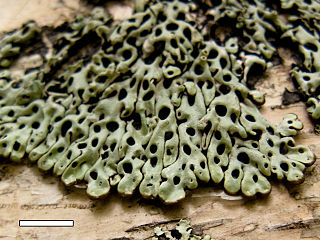
Menegazzia is a genus of lichenized fungi containing roughly 70 accepted species. The group is sometimes referred to as the tree flutes, honeycombed lichens, or hole-punch lichens. The most obvious morphological feature of the genus is the distinctive perforations spread across the upper side of the thallus. This makes the group easy to recognise, even for those not particularly familiar with lichen identification.
Menegazzia aeneofusca is a species of lichen from South America, New Zealand, and Australia.
Menegazzia confusa is a species of foliose lichen found in Australia. It was formally described as a new species in 1987 by lichenologist Peter James. The type specimen was collected by Gintaras Kantvilas near Lake Leake Road in Tasmania, where it was found growing on the bark of Exocarpos cupressiformis in a sclerophyll forest. It also occurs in Victoria. The lichen is quite similar to Menegazzia platytrema, but typically has more crowded apothecia, and lobes that are shorter and more congested. Menegazzia confusa contains caperatic acid as its primary lichen product, whereas M. platytrema contains stictic acid and related compounds.
Menegazzia enteroxantha is a species of foliose lichen found in Australia. It was first formally described as a new to science by Swiss botanist Johannes Müller Argoviensis in 1896, as a specis of Parmelia. Rolf Santesson transferred the taxon to genus Menegazzia in 1942.
Menegazzia fertilis is a species of foliose lichen found in Australia. It was described as new to science in 1992.
Menegazzia fissicarpa is a species of foliose lichen found in Australia. It was described as new to science in 1992.
Menegazzia foraminulosa is a species of corticolous (bark-dwelling), foliose lichen that is endemic to New Zealand. The lichen was first formally described as a new species in 1876 by August von Krempelhuber. Friedrich Bitter transferred it to the genus Menegazzia in 1901. The species contains several lichen products, including depsides, depsidones, as well as fatty acids and pigments.
Menegazzia grandis is a species of foliose lichen found in Australia. It was described as new to science in 1992.
Menegazzia minuta is a rare species of foliose lichen that is endemic to Tasmania, Australia. It was scientifically described as a new species in 1987 by lichenologists Peter James and Gintaras Kantvilas. The type specimen was collected by the second author south of Arthur River, where the lichen was found in a rainforest growing on twigs of leatherwood. The species epithet minuta refers to the small size of its thallus. Menegazzia minuta contains protolichesterinic acid, a lichen product that helps to distinguish it from the similar species Menegazzia eperforata, which instead contains stictic acid and related compounds. In a 2012 publication, Kantvilas called M. minuta "one of Tasmania's rarest lichens", characterised by a "glossy olive-brown thallus of minute, spidery lobes, densely beset with lobule-like isidia".
Menegazzia norstictica is a species of foliose lichen from Australia. It was described as new to science in 1992.
Menegazzia opuntioides is a species of foliose lichen from southern South America. It was first formally described as a new species in 1889 by Swiss botanist Johannes Müller Argoviensis, as a species of Parmelia. The type specimen was collected in the Strait of Magellan in southern Chile. Rolf Santesson transferred the taxon to the genus Menegazzia in 1942. Menegazzia opuntioides has also been recorded from Argentina.

Menegazzia pertransita is a species of foliose lichen in the large lichen family Parmeliaceae. It is found in New Zealand, Australia, and South America. The lichen was first formally described by Scottish physician and bryologist James Stirton in 1877 as Parmelia pertransita. Swedish lichenologist Rolf Santesson transferred it to the genus Menegazzia in 1942.
Menegazzia platytrema is a species of lichen found in Australia.
Menegazzia prototypica is a species of lichen found in Australia. It was described as new to science in 1992.
Menegazzia pseudocyphellata is a species of lichen found in Taiwan. It was identified in 2003 in Taroko National Park on Hehuanshan at an elevation of 3,200 meters.
Menegazzia stirtonii is a species of foliose lichen found in New Zealand, and Tasmania, Australia.

Menegazzia terebrata is a species of foliose lichen found scattered across many continents, including North America, South America, Europe, Africa, and Asia.
Menegazzia subtestacea is a species of foliose lichen in the family Parmeliaceae. It is found in Tasmania (Australia), where it grows at high elevations on the twigs and young branches of alpine shrubs.
Menegazzia tarkinea is a rare species of foliose lichen in the family Parmeliaceae. It occurs in North West Tasmania (Australia).

